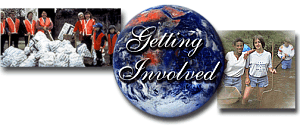Fifteen Things You Can Do to Make a Difference in Your Watershed

Learn About Your WatershedBecome Active in Your WatershedHelp Increase Public Awareness in Your Watershed |
|
 |
Learn about your watershed. Start by using the Watershed Region Information to find your watershed address and learn about its environmental health. Other useful sites include Surf Your Watershed, Envirofacts and Enviromapper. Also be sure to check out EPA's Wetlands web page to learn about the importance of wetlands. |
 |
Use EPA's Nonpoint Source Program
web pages to learn about how nonpoint source pollution affects your watershed and your
coastal watershed. Identify ways you can help prevent polluted runoff
from your home, ranch or farm. Check out Give Water a Hand
|
 |
Go on an Estuary Walk, Lake Walk, Stream Walk, or River Walk and make observations and assessments of waterbody conditions. If you see anything abnormal (such as dead fish, oil spills, leaking barrels, and other pollution) contact your city or county environmental department right away and report the nature and location of the problem. |
 |
Find out about our precious
coastal and marine resources by reading the Coastal
Watershed Fact Sheets. Learn about our pressure on ocean resources |
 |
Learn how land use and development
decisions affect your water resources and how watershed planning and
the watershed
approach can help. Find out about model ordinances to protect
water quality at EPA's Model
Ordinances to Protect Local Resources web pages and the
Center for Watershed Protection. |
 |
Find a watershed organization in your community and volunteer to help. If there are no active groups, consider starting your own. Use EPA's Adopt Your Watershed's Catalog of Watershed Groups to locate groups in your community or visit the Watershed information website How to Start a Watershed Team page. |
 |
Become a Volunteer Water Quality Monitor. Help collect water quality data and build stewardship for your local waterbody. Attend a training workshop to learn proper monitoring techniques and safety rules. Visit EPA's Volunteer Monitoring Homepage and read Starting Out in Volunteer Water Monitoring (PDF) (4 pages, 837KB). Consult the National Estuary Program's Volunteer Monitoring page for guidance in coastal areas. |
 |
Organize or join in the cleanup
of a beach, stream, estuary, or wetland. For example, participate
in the National
River Cleanup Week. |
 |
Create a Wildlife Habitat in
your Backyard, Workplace or Schoolyard. Certify your backyard or schoolyard as part of the National Wildlife Federation's Backyard Wildlife Habitat Program or Schoolyard Habitat Program. |
 |
Participate in or help coordinate
a special wetlands activity during the month of May to celebrate American
Wetlands Month. Visit EPA’s wetlands web site for ideas for special wetland activities. Also, celebrate International Migratory
Bird Day |
 |
Do your part to protect drinking water sources. Individuals, citizen groups, and local communities can participate in many activities that help to protect their drinking water sources. Get information about drinking water and how it can be protected at the EPA Source Water Protection Web site. Find out more about how your drinking water is tested, treated and protected by reading your utility's yearly water quality report. Check out the National Source Water Collaborative |
 |
Prepare a presentation about your watershed for a school or civic organization. Explain
what a watershed is. Discuss water quality threats, including polluted runoff
and habitat loss. Highlight things people can do to protect water quality, including limiting fertilizer use and eliminating herbicides
and pesticides. Be sure to provide case studies from other watersheds and to highlight success stories. Research your presentation using
a variety of water education materials.
|
 |
Organize a Storm Drain Marking Project in your neighborhood. Produce and distribute a flyer or door hanger for households to remind residents that storm drains dump directly into your local waterbody. Click here for guidelines on how to conduct a project. Visit EPA’s Stormwater Website for door hangers, videos and publications that can be downloaded or ordered for free. |
 |
Sponsor a World Water Monitoring Day Event or Watershed Festival
in your community to raise awareness about the importance of watershed
protection. Organize the event around a water body in your watershed (e.g., estuary, lake, river, etc.), an issue (protecting drinking water sources), or a national event. Find out how to get involved in or start planning your own monitoring event using the Water Environment Federation’s World Wide Monitoring Day Web site . |
 |
Learn how to fund your watershed outreach and public education efforts. Use the following EPA resources to get started: the Catalog of Federal Funding Sources for Watershed Protection, Environmental Finance Program, and the Clean Water State Revolving Fund Program. |
Click here if you'd like to receive a Certificate of Recognition for your watershed protection activities.
This is not a complete list of available resources and mention of these products does not constitute endorsement by EPA. Visit the Office of Water Homepage or the Watershed Homepage for for more information.
![[logo] US EPA](https://webarchive.library.unt.edu/eot2008/20090508142717im_/http://www.epa.gov/epafiles/images/logo_epaseal.gif)
